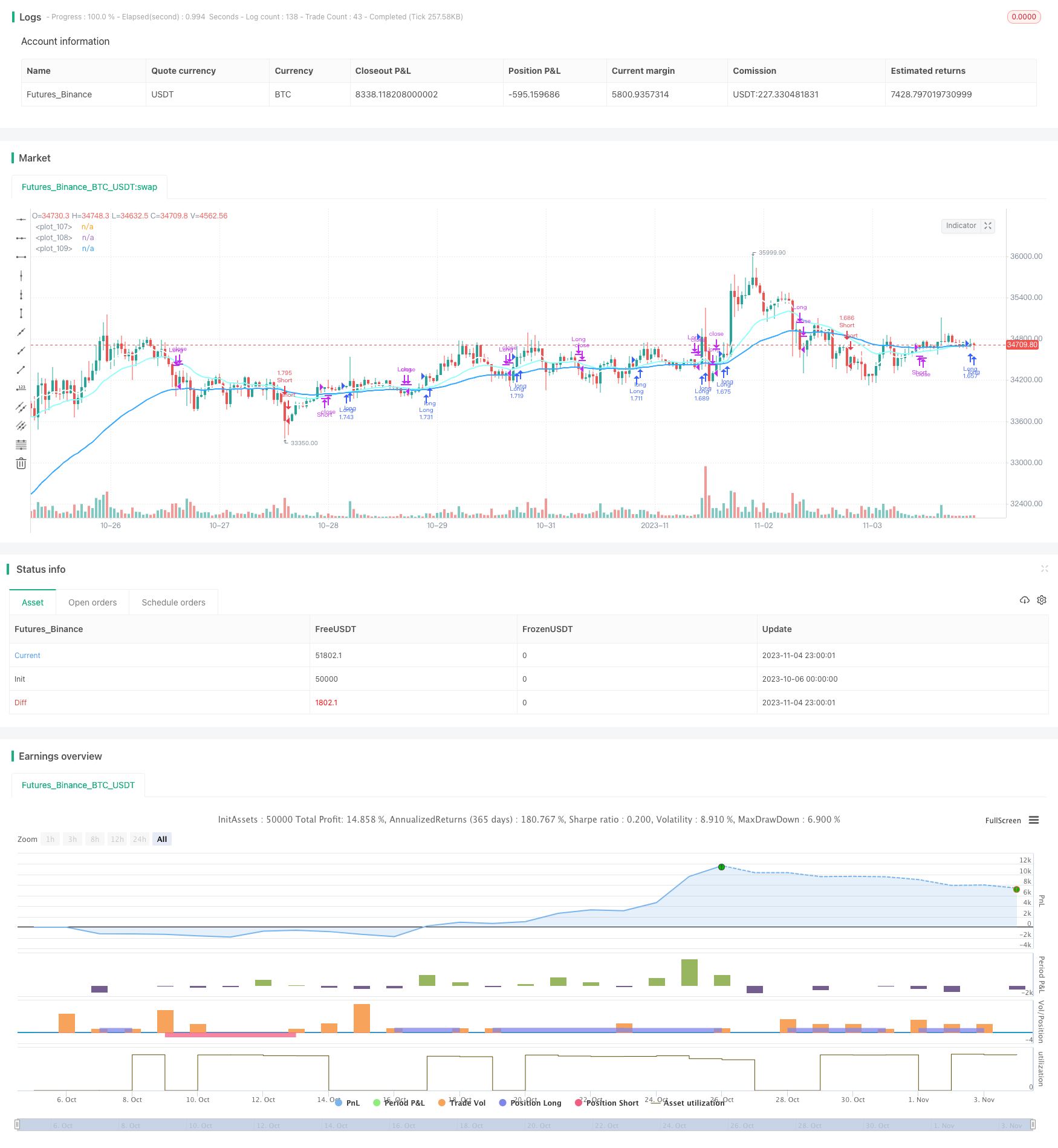
概述(Overview)
该策略采用三重移动平均线组合,根据移动平均线的顺序关系判断趋势方向,实现趋势追踪。当快速移动平均线、中速移动平均线、慢速移动平均线依次排列时,做多;当慢速移动平均线、中速移动平均线、快速移动平均线依次排列时,做空。
策略原理(Strategy Principle)
该策略使用三条不同周期的移动平均线,包括快速移动平均线、中速移动平均线和慢速移动平均线。
入场条件: 1. 做多:当快速移动平均线 > 中速移动平均线 > 慢速移动平均线时,认为行情处于上涨趋势,做多。 2. 做空:当慢速移动平均线 < 中速移动平均线 < 快速移动平均线时,认为行情处于下跌趋势,做空。
出场条件: 1. 移动平均线出场:三条移动平均线顺序发生反转时平仓。 2. 止盈止损出场:设定固定止盈止损点,如止盈幅度为12%,止损幅度为1%,达到止盈或止损价格后平仓。
该策略简单直接,利用三条移动平均线判断市场趋势方向,实现趋势跟踪交易,适合趋势性较强的市场。
优势分析(Advantage Analysis)
- 使用三条移动平均线判断趋势,过滤市场噪音,识别趋势方向。
- 采用不同周期移动平均线,可以更准确判断趋势转折点。
- 结合移动平均线指标和固定止盈止损管理资金风险。
- 策略思路简单直观,容易理解实现。
- 可方便优化移动平均线周期参数,适应不同周期行情。
风险及改进(Risks and Improvements)
- 大周期行情中,移动平均线可能产生较多误判,导致不必要的亏损。
- 可考虑加入其他指标或过滤条件,提高获利率。
- 可优化移动平均线周期参数组合,适应更广泛市场行情。
- 可结合趋势强弱指标,避免追顶杀跌。
- 可加入自动止损,避免亏损扩大。
总结(Conclusion)
该三重移动平均线趋势跟随策略整体思路清晰易懂,利用移动平均线判别趋势方向,实现简单的趋势跟随交易。策略优点是容易实现,通过调整移动平均线周期参数可适应不同周期行情。但是也存在一定的误判风险,可通过加入其他指标或条件进行优化,减少不必要的损失,提高策略获利率。总体来说,该策略适合对趋势交易有兴趣的初学者进行学习和实践。
策略源码
/*backtest
start: 2023-10-06 00:00:00
end: 2023-11-05 00:00:00
period: 1h
basePeriod: 15m
exchanges: [{"eid":"Futures_Binance","currency":"BTC_USDT"}]
*/
// This source code is subject to the terms of the Mozilla Public License 2.0 at https://mozilla.org/MPL/2.0/
// © Jompatan
//@version=5
strategy('Strategy Triple Moving Average', overlay=true, initial_capital = 1000, commission_value=0.04, max_labels_count=200)
//INPUTS
mov_ave = input.string(defval="EMA", title='Moving Average type:', options= ["EMA", "SMA"])
period_1 = input.int(9, title='Period 1', inline="1", group= "============== Moving Average Inputs ==============")
period_2 = input.int(21, title='Period 2', inline="2", group= "============== Moving Average Inputs ==============")
period_3 = input.int(50, title='Period 3', inline="3", group= "============== Moving Average Inputs ==============")
source_1 = input.source(close, title='Source 1', inline="1", group= "============== Moving Average Inputs ==============")
source_2 = input.source(close, title='Source 2', inline="2", group= "============== Moving Average Inputs ==============")
source_3 = input.source(close, title='Source 3', inline="3", group= "============== Moving Average Inputs ==============")
//EXIT CONDITIONS
exit_ma = input.bool(true, title= "Exit by Moving average condition", group="================ EXIT CONDITIONS ================")
exit_TPSL = input.bool(false, title= "Exit by Take Profit and StopLoss", group="================ EXIT CONDITIONS ================")
TP = input.int(12, title='Take Profit', step=1, group="================ EXIT CONDITIONS ================")
SL = input.int(1, title='Stop Loss', step=1, group="================ EXIT CONDITIONS ================")
plot_TPSL = input.bool(false, title='Show TP/SL lines', group="================ EXIT CONDITIONS ================")
//Date filters
desde = input(defval= timestamp("01 Jan 2023 00:00 -3000"), title="From", inline="12", group= "============= DATE FILTERS =============")
hasta = input(defval= timestamp("01 Oct 2099 00:00 -3000"), title="To ", inline="13", group= "============= DATE FILTERS =============")
enRango = true
//COMMENTS
//entry_long_comment = input.string(defval=" ", title="Entry Long comment: ", inline="14", group="============= COMMENTS =============")
//exit_long_comment = input.string(defval=" ", title="Exit Long comment: ", inline="15", group="============= COMMENTS =============")
//entry_short_comment = input.string(defval=" ", title="Entry Short comment:", inline="16", group="============= COMMENTS =============")
//exit_short_comment = input.string(defval=" ", title="Exit Short comment: ", inline="17", group="============= COMMENTS =============")
//============================================================
//Selecting Moving average type
ma1 = mov_ave == "EMA" ? ta.ema(source_1, period_1) : ta.sma(source_1, period_1)
ma2 = mov_ave == "EMA" ? ta.ema(source_2, period_2) : ta.sma(source_2, period_2)
ma3 = mov_ave == "EMA" ? ta.ema(source_3, period_3) : ta.sma(source_3, period_3)
//============================================================
//Entry Long condition: Grouped Moving average from: (ma fast > ma middle > ma slow)
long_condition = (ma1 > ma2) and (ma2 > ma3)
//Entry Short condition: Grouped Moving average from: (ma fast < ma middle < ma slow)
short_condition = (ma1 < ma2) and (ma2 < ma3)
//============================================================
cantidad = strategy.equity / close
comprado_long = strategy.position_size > 0
comprado_short = strategy.position_size < 0
var long_profit_price = 0.0
var long_stop_price = 0.0
var short_profit_price = 0.0
var short_stop_price = 0.0
//============================================================
//ENTRY LONG
if not comprado_long and not comprado_short and long_condition and not long_condition[1] and enRango
strategy.entry('Long', strategy.long, qty=cantidad, comment= "Entry Long")
if exit_TPSL
long_profit_price := close * (1 + TP/100)
long_stop_price := close * (1 - SL/100)
else
long_profit_price := na
long_stop_price := na
//============================================================
//ENTRY SHORT
if not comprado_long and not comprado_short and short_condition and not short_condition[1] and enRango
strategy.entry('Short', strategy.short, qty=cantidad, comment= "Entry Short")
if exit_TPSL
short_profit_price := close * (1 - TP/100)
short_stop_price := close * (1 + SL/100)
else
short_profit_price := na
short_stop_price := na
//============================================================
//EXIT LONG
if comprado_long and exit_ma and long_condition[1] and not long_condition
strategy.close('Long', comment='Exit-Long(MA)')
if comprado_long and exit_TPSL
strategy.exit('Long', limit=long_profit_price, stop=long_stop_price, comment='Exit-Long(TP/SL)')
//============================================================
//EXIT SHORT
if comprado_short and exit_ma and short_condition[1] and not short_condition
strategy.close('Short', comment='Exit-Short(MA)')
if comprado_short and exit_TPSL
strategy.exit('Short', limit=short_profit_price, stop=short_stop_price, comment='Exit-Short(TP/SL)')
//============================================================
//PLOTS
plot(ma1, linewidth=2, color=color.rgb(255, 255, 255))
plot(ma2, linewidth=2, color=color.rgb(144, 255, 252))
plot(ma3, linewidth=2, color=color.rgb(49, 167, 255))
//Plot Take Profit line
plot(plot_TPSL ? comprado_long ? long_profit_price : comprado_short ? short_profit_price : na : na, color=color.new(color.lime, 30), style= plot.style_linebr)
//Plot StopLoss line
plot(plot_TPSL ? comprado_long ? long_stop_price : comprado_short ? short_stop_price : na : na, color=color.new(color.red, 30), style= plot.style_linebr)